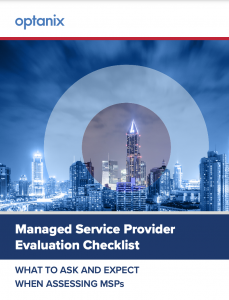
What Are Managed IT Network Services?
In this post, we’ll examine what is meant by managed IT network services and drill down into the services that are typically delivered.
Managed network services (or MNS) refers to a vendor’s delivery of operational support for an infrastructure environment. In the MNS scenario, the hardware assets, financial obligations, and personnel still remain on the books of the customer.
Enterprise IT organizations typically outsource managed IT network services to be remotely operated, monitored, and maintained by a managed network service provider.
As Gartner explains: “Enterprises struggling to balance expense optimization with greater network agility and performance are increasingly choosing managed network services.”
 Need insight on evaluating a managed service provider for your organization? Download this MSP Evaluation Checklist to ensure you select the best partner.
Need insight on evaluating a managed service provider for your organization? Download this MSP Evaluation Checklist to ensure you select the best partner.
Services Are Labor-Intensive
The MNS provider manages the hardware and software components that constitute the actual network infrastructure, as well as the processes, staff, and tooling that provide the operational capability to install, monitor, troubleshoot, and be the single point of contact to support the ecosystem.
MNS are remotely delivered services from the provider’s NOC, commonly with a separate disaster failover site to provide the need for operational resiliency.
The benefits of this approach are financial, but also allow organizations to focus on their core business without the distraction of the overhead of managing the day-to-day issues around keeping the network infrastructure up and running.
The amount of highly-skilled labor required to plan, design, build, and operate internally with Do-It-Yourself NOCs is considerable. In fact, this requirement directly drives most IT organizations to partner with an MNS provider to meet their IT network infrastructure services needs.
To better understand Managed IT Network Services, let’s look at it from a capabilities’ perspective. These capabilities include the quality of service delivery, network operations automation, and customer experience management.
Delivery of Quality Service
The primary goal of the service provider is to deliver service quality. This includes the processes, tools, and personnel to provide integrated service management across the MNS solution.
Key aspects to deliver on this goal include:
- Service delivery platforms, which comprise the hardware, software, applications, security, and scalability components of the provider’s infrastructure for delivering MNS. Providers with a mature platform with full-stack monitoring plus troubleshooting capabilities have a clear advantage versus vendors that depend on cobbled-together solutions to satisfy their delivery platform needs.
- Process frameworks, which provide repeatable, standardized, and structured mechanisms to ensure quality and cost efficiencies to the end customer. Most MNS providers adapt ITIL-based frameworks to achieve these goals.
- The ability to meet security, audit, and data protection governance needs.
- The ability to provide professional services elements such as customer onboarding, change, and configuration management.
Network Operations Automation
Automations drive the efficiency and ability of the software delivery platform to scale. Automations reduce the errors tied to manual operations and remove the tedious nature of repetitive tasks.
Managed network services leverage many technical domains including AIOps, IT operations management (ITOM), IT service management (ITSM), and network performance and diagnostic (NPMD) capabilities. Network operations automation needs to work across all these layers in order to truly realize the benefits that are available.
The other area that benefits greatly from automation is the service requests affecting change and configuration, event processing, and incident management activities.
Automations are a valuable tool for both the provider and the IT organization. Providers benefit from the efficiencies that automation delivers, and IT organizations realize higher-quality services and improved cost predictability.
Customer Experience Management
Both the service delivery quality and network operations automation directly contribute to a higher level of customer satisfaction. Here are some other aspects of quality service delivery that will improve the experience of your IT organization.
- To truly manage the customer experience, it is essential for MNS providers to provide a customer portal. The customer portal forms the basis for interaction with the MNS provider. It provides real-time information on service requests, incidents, and the performance of the entire scope of the MNS provider’s responsibility
- Anomaly detection is another aspect directly tied to improved service delivery. By establishing baselines of network behavior, it is possible to proactively identify aberrations and address them before they become incidents affecting the IT organization and its end customers.
- The most impactful is probably the ability to deliver effective business impact management. The nature of an infrastructure issue does not really make sense if not established within the context of the business impact. It must be delivered using the language and terminology of the IT organization and its services.